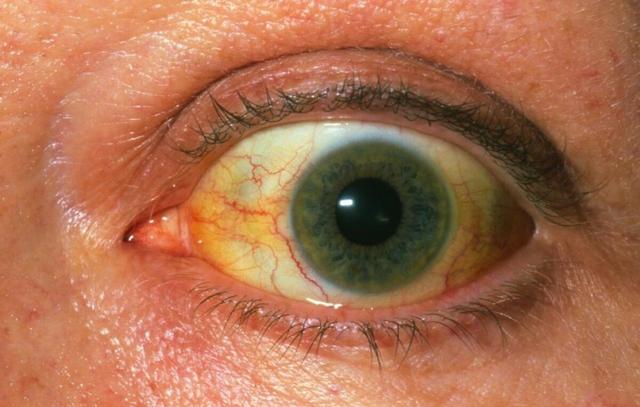
You’ve looked in the same mirror for years. You know your own face—the laugh lines you’ve earned, the wisdom in your eyes, the familiar landscape of a life well-lived. So, when something new appears, you notice. It might be subtle at first, a faint, buttery hue where you’re used to seeing bright white. Or it might be unmistakable: a clear, yellow tint to the whites of your eyes.
It’s a sight that can stop you cold. It feels ancient, almost biblical. And your mind, searching for a reason, might land on the most serious one. Yellow eye whites? Your liver is failing…
While it’s true that yellow eyes, a condition called jaundice, are a classic sign of serious liver distress, that statement is both accurate and an oversimplification. It’s like seeing smoke and concluding the whole house is on fire. The smoke is a critical signal, but the fire could be in the kitchen, the fireplace, or indeed, the foundation. Jaundice is your body’s powerful, unignorable smoke alarm. It means your body’s filtration and waste-removal system is overwhelmed, and the liver is often at the center of the crisis.
The “Why”: A Traffic Jam in Your Bloodstream
To understand jaundice, we need to talk about a natural waste product called bilirubin. Your body is constantly recycling old red blood cells. As these cells break down, they release bilirubin, a yellow-orange pigment. It’s the liver’s job to process this bilirubin, mix it into bile (a digestive fluid), and send it out of the body through your stool.
Jaundice occurs when this efficient disposal system breaks down. Bilirubin builds up in your bloodstream, and like a dye, it starts to stain your tissues. The whites of your eyes (the sclera) are often the first place it becomes visible because they are rich in a protein that bilirubin easily binds to.
So, the yellow is literally a backlog of waste. The critical question is, where is the blockage?
The Three Stations of the Crisis
Doctors often look at three main areas where this bilirubin “traffic jam” can happen.
- Before the Liver (Pre-Hepatic): The problem isn’t the liver itself, but the “supply chain.” If there is a condition causing red blood cells to break down too rapidly—a condition called hemolysis—the liver simply can’t keep up with the flood of bilirubin. It’s like a recycling plant being inundated with more trash than it can process.
- In the Liver (Hepatic): This is the failure we most fear. The liver cells themselves are damaged and can’t do their job. This is where the headline rings true. Causes include:
- Hepatitis: Inflammation of the liver, which can be from viruses (Hepatitis A, B, or C), from heavy alcohol use (Alcoholic Hepatitis), or from a build-up of fat (Nonalcoholic Fatty Liver Disease, very common in midlife).
- Cirrhosis: This is late-stage scarring of the liver, where so much healthy tissue has been replaced by scar tissue that the organ simply can’t function. It is the result of long-term, ongoing damage.
- Toxins or Medications: Certain drugs, herbs, or toxins can be harsh on the liver, causing damage that impairs its function.
- After the Liver (Post-Hepatic): The liver is working fine, but the “drainpipe” is clogged. The bilirubin-processed bile can’t get out. This is often caused by:
- Gallstones blocking the bile duct.
- Pancreatic Cancer or other tumors pressing on and obstructing the bile ducts.
- Inflammation of the bile ducts.
The “Failing” Truth: A Spectrum of Severity
Saying your liver is “failing” from yellow eyes alone is a leap. The liver is an incredibly resilient organ. Jaundice can signal anything from a temporary, treatable infection (like Hepatitis A) to a blocked duct that can be cleared, to the chronic, progressive scarring of cirrhosis.
The word “failing” is a urgent call to action, not necessarily a final verdict.
Your Action Plan: This is a Medical Emergency
Unlike a rash or a cough you might monitor for a few days, yellow eyes are a “stop everything and see a doctor now” symptom.
- Do Not Wait. This is not something to “keep an eye on.” Call your doctor immediately or go to an urgent care clinic or emergency room. State clearly: “The whites of my eyes have turned yellow.”
- Look for Other Clues. Tell your doctor if you have any other symptoms, which can help pinpoint the cause:
- Dark, tea-colored urine
- Pale, clay-colored stools
- Itchy skin
- Abdominal pain or swelling
- Nausea or vomiting
- Overwhelming fatigue
- Expect Diagnostic Tests. Your doctor will immediately order blood tests (a liver function panel) to measure your bilirubin levels and check how well your liver is working. They may also order an ultrasound to look for gallstones or blockages.
Yellow eyes are your body’s most dramatic way of waving a red flag. It is a sign that a vital system for processing waste is in crisis. While it can mean your liver is in serious trouble, it can also signal a blockage that is fixable or an infection that can be treated. By acting with urgency, you are giving yourself the best possible chance for a positive outcome. You are using your wisdom to heed a critical warning, ensuring you get the diagnosis and care needed to address the problem, whatever its source may be.